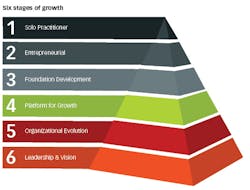Building your practice— Stage 6: Leadership and vision
41+ offices
Vincent Cardillo, MBA
Editor’s note:This article is the final installment in a seven-part series. Find the first six articles on DentalEconomics.com. Search “Cardillo, building your practice.”
In my first article, I noted that private-equity-backed multilocation group practices or dental service organizations (DSOs) are becoming more influential and are controlling a larger portion of the dental market. In my 20-plus years of experience growing DSOs, I’ve identified all successful, developing groups’ progress through Six Stages of Growth. Therefore, as you transition from solo practitioner (Stage 1), through entrepreneurial (Stage 2), to foundation development (Stage 3), to platform for growth (Stage 4), to organizational evolution (Stage 5), and finally, to leadership and vision (Stage 6), following these progressive steps will facilitate your ongoing growth.
Last month’s article highlighted Stage 5 (21 to 40 offices), where you create your C-suite, consider financial restructuring, and establish a call center. This month’s article focuses on Stage 6 (41+ offices). This is where you (1) continue to duplicate the model you’ve created while bringing departments previously outsourced back in-house, (2) accentuate leadership development and training, and (3) ensure effective communication systems are in place. At the end of the article, I’ll summarize the Six Stages of Growth.
You’ll need to make decisions around the components of Stage 6 that are outlined in this article:
Moving functions in-house
With more than 40 offices, it’s time to reevaluate your outsourcing strategy, because at this point you can afford to hire the best. During prior stages, cash flow and financial resources had an influence on your seeking alternatives to hiring full-time team members to manage a department. In fact, you may have used virtual team members and third-party organizations to leverage the expertise of trained professionals to assist in scaling a department or to serve as one of your departments. However, at a certain point, the price for such a service costs more than it would to bring that function back in-house. As an example, you may evaluate your legal expenses and determine that you could hire someone in-house for less than you’re paying your current firm. This same model could be used for other departments in your organization.
With the C-suite expanding and the practice support team growing internally, it is paramount to revisit your leadership, training, and development to ensure you have high-level, ongoing growth focused on your organization’s values and the future of your teams.
Strengthening leadership
As you continue to grow practices, it is imperative to strengthen your training and leadership development programs. It is important for the leaders of the organization to identify, train, and mentor future stars, not only to support the size and growth of the organization, but also to make subsequent growth as seamless as possible. In fact, at this point it is paramount to hire a trainer who specializes in large organizations. This person will assist you with putting together a training and development curriculum tailored to your company’s specific values and needs, for all teams, including the C-suite.
Additionally, forming committees is integral to training, mentoring, and developing future leaders. These committees will help to identify, strategize, and plan the roadmap for the future. As part of this path of leadership development, enrolling team members and doctors to be members of certain committees gives them the experience of working with other leaders and enables them to be part of the decision-making process.
Some committees to consider forming are a dental laboratory committee (determines who the preferred vendors will be), quality assurance committee (oversees and manages quality of care), and supplies and technology committee (determines what materials should be used and what new technologies are more efficient and provide better care).
Just as various committees foster better decision-making and leadership development, establishing a communication plan in your dental organization is equally important.
Fostering communication
Effective communication supports good relationships between you and your teams and enhances productivity while continuing to emphasize your values, which positively impacts culture. You may have people working in different parts of the country, which can present challenges when people are communicating throughout the organization. Therefore, it is important to determine a means of communication (e.g., phone, virtual, or in person) and scheduling, and to identify who will communicate and how often.
Spotlight: The foundation
The secret to growing your practice is staying ahead of the game, continuing to build out your infrastructure so that it’s ready to handle new offices as you acquire them. During the six stages, you create a foundation for growth bit by bit that can hold up your organization as it expands through acquisitions, de novo practices, or both.
Key to supporting your goals for growth is software, such as Dentrix Enterprise, designed for multisite practices. Your practice management software plays a big role in your success because it allows you to centralize data in a single database; use a call center; centralize billing and accounting, insurance management, and collections; and get the metrics you need with custom reporting.
One of the benefits is how your software can enable consistency across offices so that your practice can run more cohesively with standard policies and procedures. This creates a culture of efficiencies that save time and money, which, when multiplied organization-wide, can significantly add to your bottom line.
Spotlight sponsored by Henry Schein’s Dentrix Enterprise
For example, you’ll need to determine who needs to be part of certain conference calls and how often. In addition to regular calls, you’ll need to establish how often small or large live meetings or events will occur, where they will be held, and who will attend. You may also want to consider incentivizing this process. For example, invite a top performer to attend with his or her supervisor. This type of employee incentive positively impacts future leadership development opportunities. While live meetings may present significant costs and scheduling challenges, using virtual meeting space is a good alternative. Whichever communication methods you use, ensure that participants are prepared, contributing, and engaged in the process. It’s important that the entire organization is well-informed on everything that’s happening in the organization. Use communication as an opportunity to instill the values and culture that has made you who you are and who you will become.
Six Stages of Growth: Summary
Consider the Six Stages of Growth that I’ve outlined as the progressive steps necessary to grow from a solo office to a large group practice or DSO. If you’re struggling, for example, in Stage 2, you’ll need to ask yourself, “Should I be moving on to Stage 3 and acquiring additional offices?” No. Instead you’ll need to stop, get organized, invest fully in that stage, and take the next step when you’re fully prepared.
In Stage 1: solo practitioner (one office), for example, key decisions center largely around defining your niche, choosing a location, deciding whether to build or buy an office, naming your practice, and establishing your practice’s culture or MPV (mission, purpose, and values). You can leave things here, but if you’re planning to expand, Stage 2 is by far the most crucial stage.
During Stage 2: entrepreneurial (two to three offices), you not only make decisions based on how they’ll work across multiple offices, you also establish your infrastructure and delegate responsibilities to others while creating accountability. You also identify key performance indicators (KPIs) that are most important to your business, and regulate training needs as you develop a deep understanding of your financials. Mentoring and training become important for both your clinical and nonclinical team members.
Stage 3: foundation development (four to nine offices),is your “aha!” moment—you realize things run just fine when you’re not there. You decide what functions to centralize or decentralize while outsourcing tasks to ensure you have the best people for the job. As you continue to leverage resources and scale your business, you follow either an acquisition or de novo model while determining whether your locations will be branded or nonbranded.
As you add additional practices during Stage 4: platform for growth (10 to 20 offices), you need to create a transition process that systematically integrates acquired or launches de novo practices. While you need more doctors, you must consider both the associateship and partnership models. In this stage, you also define your role in the company and determine if you are the chief executive officer (CEO) or chief dental/clinical officer (CDO/CCO). Once you decide this, you hire for the other position.
AtStage 5: organizational evolution (21 to 40 offices), you continue to evolve your organization. This is done by creating your C-suite while considering financial restructuring and establishing a call center.
Finally, during Stage 6: leadership and vision (41+ offices), you’ll emphasize the growth of your organizational chart relative to the functions that can now be brought back in-house. Ongoing leadership development and a concise communication structure are paramount to achieving your goals. Once you have mastered these stages, the number of offices you can expand to is practically limitless.
Conclusion
No matter what stage you’re in, you have the opportunity to participate in a thriving industry. Whether your goal is to have two, 200, or even 2,000 offices, the information in my seven-article series serves as a great starting point. From here, you’ll need to educate yourself and enlist the help of your team, peers, and consultants.
Vincent Cardillo, MBA, has more than 20 years of experience owning, leading, and partnering with DSOs, the latest of which was No. 14 on the 2014 Inc. 500 List. He is the founder of Dental Management Innovations LLC (DMI). DMI positions clients for growth by strengthening their operational systems and infrastructure. Mr. Cardillo also provides his expertise to private equity firms and institutional investors. His book on the six stages of growth will be published later this year. Contact him at [email protected].


